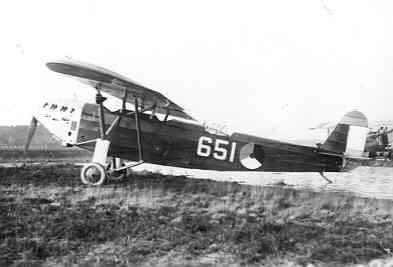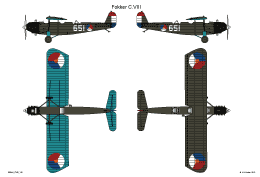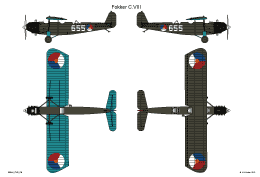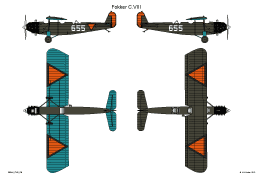History
This heavy, long-distance three seat scout was designed in 1927 in response to LVA requirements for a scout.
In December of the same year an order followed for Fokker, who built the aircraft in close cooperation with the LVA.
In the summer of 1928 the C.VIII was completed and it met all LVA requirements.
On August 29, 1928 it entered service with registration 651. Rather unusual at that time was Fokker also delivered the engine, a Hispano-Suiza of 600 hp.
The Fokker C.VIII was a high-wing parasol, the pilot was sitting in front of the wing, the two observers sat in a row behind the wing.
Between the two observers was a so called "office" was decorated with room for a desk, cameras and the like.
The armament they had access to was a rotating machine gun on a Scarff ring called the rear observer and a machine gun in the bottom for the forward observer.
Fokker later developed a seaplane version of the C.VIII, designated C.VIIIw, which had incorporated many improvements. This type was delivered to the RNlNAS (MLD).
In 1933 Fokker offered an improved version, but this was not accepted
| Dimensions: | |||
| Length: | 10,60 m | Wingspan: | 14,03m |
| Height: | - m | Wing area: | - m2 |
| Weights: | |||
| Empty weight: | 1650 kg | Max. start weight: | 2500 kg |
| Performances: | |||
| Max. speed: | 230 km/hr | Rate of climb: | - m/min |
| Range: | 670 km | Service ceiling: | 6500 m |
| Miscellaneous: | |||
| Engine: | One Hispano Suiza HS-12Lb rated 650 pk | ||
| Crew: | Three men | ||
| Armament: | - | ||
Soesterberg was it any further testing. The pilots, however, had many complaints.
The position of the pilot was wrong, but according to Fokker this was according the requirements.
Furthermore, the manoeuvrability and performance was poor, but Fokker stated this was a consequence of the requirements. The performance would be significantly improved with a slimmer body.
The LVA realized that for reconnaissance a smaller more agile aircraft like the CV, came up well over the big, bulky C.VIII.
The Fokker C.VIII was rarely used.
Until 1934 it was assigned to the SVA, (Staf Vliegtuig Afdeling), the Staff Aircraft Division, then was assigned to the flight school.
In 1938, now with the new serial 655, it was for major repairs at the LVB (LuchtVaart bedrijf), at Soesterberg and probably written off in 1939.

[Enclosed photo from BeeldBank NIMH. Click on photo for ordering information]

[Enclosed photo from BeeldBank NIMH. Click on photo for ordering information]
| Serial | Constr. nr. | Date in service | Date out of service | Notes |
|---|---|---|---|---|
| 651 | 29-08-1928 | 1939 ? |
1/72nd Scale
Kits
- --
- Kit --: ---
Modelling add-on
- --
- Set --: --
Decals
- --
- Set --: --
1/48th Scale
Kits
- --
- Kit --: --
Modelling add-on
- --
- Set --: --
Decals
- --
- Kit --: ---
| Scheme | Colour name | WEM | Humbrol | XtraColor | Vallejo Model Color | Vallejo Model Air | |
|---|---|---|---|---|---|---|---|
| Standard #1 | Upper surfaces | LVA Khaki | AC D04 | 29? / 155? | x2? /x251? | 70.921? / 70.887? | |
| Undersides | LVA Blue | AC D05 | 115 ? | X-214? | |||
Check www.paint4models.com for an extensive conversion table with lots of colour and paint systems.
Literature.
| Nederlandse Militaire Luchtvaart in Beeld.deel 1. | Hugo Hooftman | Pag. 108 | 1977 | Uitgeverij: Europese Bibliotheek; Zaltbommel |
| Fokker, Bouwer aan de wereldluchtvaart | Thijs Postma | Pag. 76 - 77 | 1979 | Uitgeverij Unieboek b.v., Houten |
| De Nederlandse Vliegtuigen; Alle vliegtuigen ooit in Nederland ontworpen en gebouwd | Theo Wesselink & Thijs Postma | Pag. 75 | 1982 | Uitgeverij Romen Luchtvaart, Haarlem |
| Luchtvaartwereld; 2e jaargang nummer 11: Fokker C.VIII; De "zwangere eend" | Frits Gerdessen | pag. 321 - 322 | 1985 | Uitgeverij Ten Brink, Meppel |
| KLu Vliegtuigen: De vliegtuigen van de Koninklijke Luchtmacht vanaf 1913 | Wim Schoenmaker & Thijs Postma | Pag. 50 | 1987 | Uitgeverij De Alk, Alkmaar |
| Camouflage en Kentekens | J.Greuter e.a. | 1997 | Bonneville – Bergen (NH) |
Websites.
--




 Nederlands (nl-NL)
Nederlands (nl-NL)  English (United Kingdom)
English (United Kingdom)